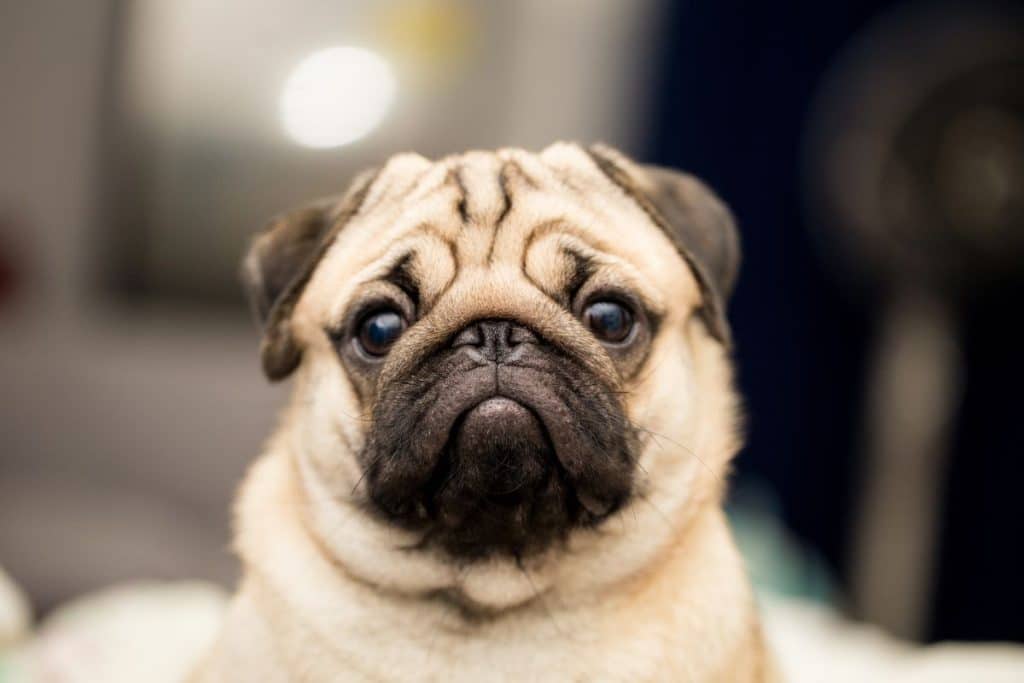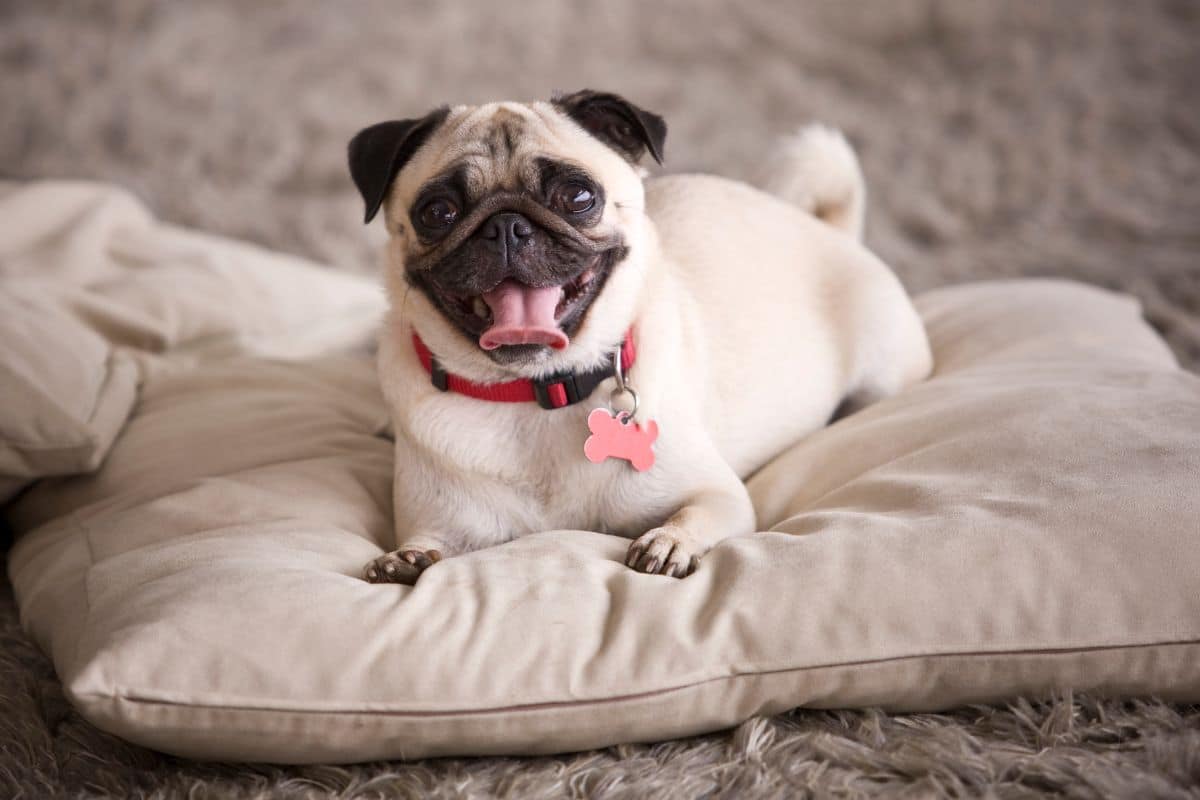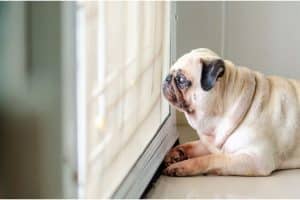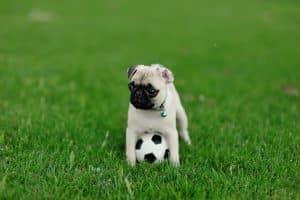Pugs are a funny, lovable and sociable dog breed. But, despite their adorable looks and big personalities, this breed is actually quite hard to care for.
They are also prone to several rare diseases because of the way that they have been bred.
Because of this fact, there are several things that you need to learn about pugs in order to prolong their life.
So, in this article we are going to cover how long pugs live, what you can do to help your pug live a long and happy life, what are some common things that pugs commonly die of, and finally what you can do to make those last moments with your beloved pet something to remember.
In this article we are going to talk about how long pugs live and what you can do to prolong their life span.
Pugs tend to live for between twelve and fifteen years.
In order to prolong their life span you can do things like watch their weight, take them for regular visits to the vet and feed them good quality food.
With all of that being said, it is finally time to dive into the meat and bones of this article. So, without further ado let us dive right in!
What Is The Average Length Of Time Pugs Live?
According to several studies pugs generally live for between twelve and fifteen years. The average lifespan for female pugs is just about thirteen years while males live an average of twelve years.
But, if you do all the right things you can actually keep your pug alive for fifteen years or more. There was a pug named King Tug that lived for eighteen years. So, it is possible for pugs to live a long time.
What If Your Pug Is Obese?
Because of the way that pugs are bred, they have the tendency to be lazy, and overheat easily. They also like to sleep a lot and are not the best at walking.
These ‘lazy’ traits are often what allow pugs to become obese.
When pugs are overweight pugs can suffer from breathing difficulties, cardiac issues and other diseases that can shorten the life of your pug.
What If Your Pug Has Pug Dog Encephalitis?
Doges that have been diagnosed with pug dog encephalitis or PDE can have a diminished quality of life. This disease tends to inflict pugs between the ages of two and three.
On top of that females are more prone to this disease than the males. But what makes this disease more scary is the fact that there is no clear root cause of the disease and there is no cure for it yet.
You can ease the symptoms of PDE, but your pug may not live as long as normal. The average age for pugs with PDE is ten years.
What If Your Pug Is Diabetic?
Pugs with diabetes are able to live relatively normal lives as long as you stay on top of the condition. In fact, pugs with diabetes can live the normal amount of time as a healthy pug.
Just make sure that the diabetes is managed and medicated properly otherwise your pugs’ life may be cut short, and we wouldn’t want that.
What Is A Pug’s Age In Human Years?
It is quite important to understand how old your pug is in human years and in dog years. This allows you to understand what point your pug is in throughout their life.
Let us take a look at how old your pup is in human years:
- 1 Human Year for a Pug is Equivalent to a 15-Year-Old Human
- 2 Human Year for a Pug is Equivalent to a 24-Year-Old Human
- 3 Human Year for a Pug is Equivalent to a 28-Year-Old Human
- 4 Human Year for a Pug is Equivalent to a 32-Year-Old Human
- 5 Human Year for a Pug is Equivalent to a 36-Year-Old Human
- 6 Human Year for a Pug is Equivalent to a 40-Year-Old Human
- 7 Human Year for a Pug is Equivalent to a 44-Year-Old Human
- 8 Human Year for a Pug is Equivalent to a 48-Year-Old Human
- 9 Human Year for a Pug is Equivalent to a 52-Year-Old Human
- 10 Human Year for a Pug is Equivalent to a 56-Year-Old Human
- 11 Human Year for a Pug is Equivalent to a 60-Year-Old Human
- 12 Human Year for a Pug is Equivalent to a 64-Year-Old Human
- 13 Human Year for a Pug is Equivalent to a 68-Year-Old Human
- 14 Human Year for a Pug is Equivalent to a 72-Year-Old Human
- 15 Human Year for a Pug is Equivalent to a 76-Year-Old Human
- 16 Human Year for a Pug is Equivalent to an 80-Year-Old Human
- 17 Human Year for a Pug is Equivalent to an 84-Year-Old Human
- 18 Human Year for a Pug is Equivalent to an 88-Year-Old Human
What Is The Most Common Cause Of Death For Pugs?
There are several reasons that a pug might die younger than normal. The main causes for the death of pugs are as follows:
- Congenital Disease – This essentially means that your pug has died from an illness that has been present throughout your pugs’ life. They can include stenosis, heart defects, septal defects, and several other issues.
- Cancer – There are several types of cancer that are present in pugs. The most common cancers that cause death are as follows: mammary tumours, skin tumours, mouth cancer, testicular cancer, and lymphoma. Cancer is treatable if it is caught early enough. But if you leave it too long the disease may spread to the point of no return.
- Neurological Disorders – Pugs are prone to several conditions that can affect their nervous system. These ailments can cause issues in your pugs, the spinal corn, brain and other parts of the body. The main disorder that affects pugs is known as PDE, it causes brain inflammation which can in turn cause your pug to become lethargic, lose control of their muscles and in extreme cases it can cause seizures.
- Infections – Skin or yeast infections are not typically life-threatening. They can however be serious enough to cause both viral and bacterial infections which can cause some diseases to develop. This can cause death in extreme cases.
- Diet – Dogs should always be fed a proper diet. They have nutritional requirements which are necessary for them to live long and healthy lives. For this reason it is essential that your pug gets everything that they need in their diet.
What Happens To Pugs When They Age?
According to studies done by veterinarians, pugs are considered to be senior animals when they are between seven and nine years of age.
It is important, as a dog owner, to see the signs of when your dog transitions from being a young adult dog to a senior dog so that you can better care for them and their new needs.
Here are some of the signs to look out for when you have a pug that is nearing the age when they could be considered to be a senior:
- Loss of Hearing – it can be really tough on a dog to lose their hearing as they rely on this sense quite a lot. In order to combat this you can try teaching your dog hand signals so that you can still communicate with them always so that they are able to understand.
- Altered Muscle to Fat Ratio – Similar to humans, as a dog starts to age they lose their muscle mass and instead start to store more fat. This is an important sign to take note of so that you can alter your pugs’ lifestyle to avoid them becoming obese.
- Physical Immobility – The way that pugs are built means that there is more strain put on the joints on this breed of dog. As they grow old pugs can develop arthritis which can further handicap their movement.
What Can You Do To Prolong A Pug’s Life?

With all of this doom and gloom, it can be hard to see the bright side of owning a pug. But that does not mean that your pug can live a long and happy life.
With the proper care your pug can prosper in your care and in this section we are going to talk about what you can do to make that happen.
Keep An Eye On Your Pugs Weight
The weight of your canine companion can be a big factor in your pugs’ health. One of the biggest issues is the fact that by being obese your pug can develop a wide variety of alternative secondary diseases and conditions.
But, how can you combat these issues? Well, start off by giving your pug the best high quality and healthy foods. In short, you need to be firm with your pug.
Only give them a predetermined amount of food and no more. Do not give into their puppy dog eyes and begging. They will thank you in the long run.
If you are not sure about what weight is healthy for your pug, do not worry! Below we have listed what weight your pug should be based on their age:
- 8 Weeks – 4 Pounds
- 9 Weeks – 4.5 Pounds
- 10 Weeks – 5 Pounds
- 11 Weeks – 5.5 Pounds
- 12 Weeks – 6 Pounds
- 13 Weeks – 6.5 Pounds
- 14 Weeks – 7 Pounds
- 15 Weeks – 7.5 Pounds
Keep In Mind That Pugs Are A Brachycephalic Breed
Pugs are what is known as a brachycephalic breed. They have been bred with a short snout, heavy body and a short muzzle.
For this reason you need to keep an eye on your pug when they are near water. You could even put a life jacket on them to make sure they do not drown should they venture into the water.
By doing this you are also keeping them calmer so that they do not overexert themselves and by extension their breathing does not become distressed.
This does not mean that your pug should not exercise at all. You just need to pace them so that they do not get exhausted.
As they are a Brachycephalic breed, Pugs may also be prone to sunstroke and heat exhaustion in high temperatures, so do not walk them in extreme heat, and always ensure they have access to drinking water.
Keep Up With The Dental Work
All dogs need to get their teeth cleaned properly. You can take them to the vet for a routine cleaning or use a doggy toothbrush to clean their teeth yourself.
Senior pugs in particular tend to lose their teeth as they get older which is why you need to take care of them throughout their life.
As your dog gets older it might be prudent to switch their regular food for something soft so that it does not damage their teeth and it can be digested more easily.
Keep An Eye On Your Pugs Joints
As dogs get older they become more susceptible to arthritis and other joint related illnesses. This is because they may be overweight which puts strain on the bones and joints.
Additionally, these dogs have quite short legs which can make it harder for them to carry a lot of weight.
Feed Your Elderly Pug Senior Food
As your pug ages they may need to be switched to a senior dog food so that they get all the proper nutrients.
The correct food with the correct quantities is important for your dog. Your aged pug may also need supplements to keep them on track and healthy.
Keep In Mind That Pugs Need Proper Eye Care
Pugs are particularly prone to eye conditions like glaucoma. This is because of their bulging eyes.
Many pugs and other breeds of dog lose their eyesight with age. It is important to keep an eye out for any eye related conditions to keep your pug healthy and happy.
Weakening Bladder Control
Older dogs often lose control of their bowels and bladder. The muscles become weaker with age which can mean that you need to take your pug outside for bathroom breaks far more often than you used to.
If you can’t do that then you may want to consider putting your dog in nappies so that there are fewer accidents in the house. This reduces the risk of you scolding them when they can’t really help themselves.
It is simply something that comes with age and because of that you may want to get a good urine carpet cleaner to make the clean-up easier to handle.
Regular Visits To The Vet
Older dogs can have a whole host of health problems, because of this it is recommended that you take them to the vet regularly.
This can allow you to screen them for any issues that you have not noticed.
Keep Up With Grooming For Your Pug
Pugs are wrinkly dogs and because of this you need to make sure to groom them properly to avoid the shedding.
The older a pug gets the more prone to infection they become.
Make Sure Your Pug Gets Plenty of Exercise
Pugs are not very active dogs. In fact, it can be risky to over exercise a pug due to their respiratory issues.
Despite all that you need to make sure that they receive at least some light exercise so that their heart stays strong. You only need to take them for short walks.
Just avoid taking them out on hot days so that they do not overheat.
Is Your Pug Dying?
When you first look into the eyes of your beloved puppy pug the last thing you think about is their death. But it is important to know what to look out for when your pug reaches their senior years.
Below are a list of behaviours that are common when a pug has started to reach the end of their life:
- They Lose Interest – As your dog gets closer to death you may notice that they lose interest in the people and toys around them.
- They Lose Their Energy – As your pug gets closer and closer to death they may start to lose energy and may even stay in one spot in the house.
- They Lose Control of Their Bowels – The organs of your pug may start to shut down as they near death and this can mean more accidents in the house.
- They Lose Their Appetite – Your pug may eat far less than usual when they are close to death. This is because their digestive systems start to shut down.
- Their Breathing Becomes More Laboured – Your pug may start to lose their breath more quickly. This may mean that they take longer to catch their breaths or they may exhale for longer than usual.
Saying Goodbye
Saying goodbye to a beloved family pet can be an utterly tragic event. But it is important to realise that there are a few things that you can do to remember your pug after they are gone.
Below are a few things you can do when you need to say goodbye to your pug:
It Might Be Kinder To Put Them To Sleep
Sometimes when a dog reaches a certain age and their health starts to massively deteriorate it may be the kind thing to put them to sleep so that they are not suffering.
At The End You Should Be With Them
When the time is near you should make sure to spend all your time with your canine companion. Whether they are being put down at the vet or you are allowing them to die of natural causes at home.
You should spend your time with your pup so that they are not alone when they pass.
You Could Plan A Ceremony
One of the best things to do when your pug has sadly passed away is to hold a funeral ceremony for them. This can help you to mourn and say goodbye.
Final Thoughts
We hope you have enjoyed this article and learning all about pugs. There is a lot of information on how long pugs live for and what you can do to make sure that they live a long and happy life.
In fact, there is a lot more information that we have not been able to cover. So, make sure to do additional research in order to keep your pug happy and healthy.
Have a fantastic day to you and your pug friend. Goodbye for now!




